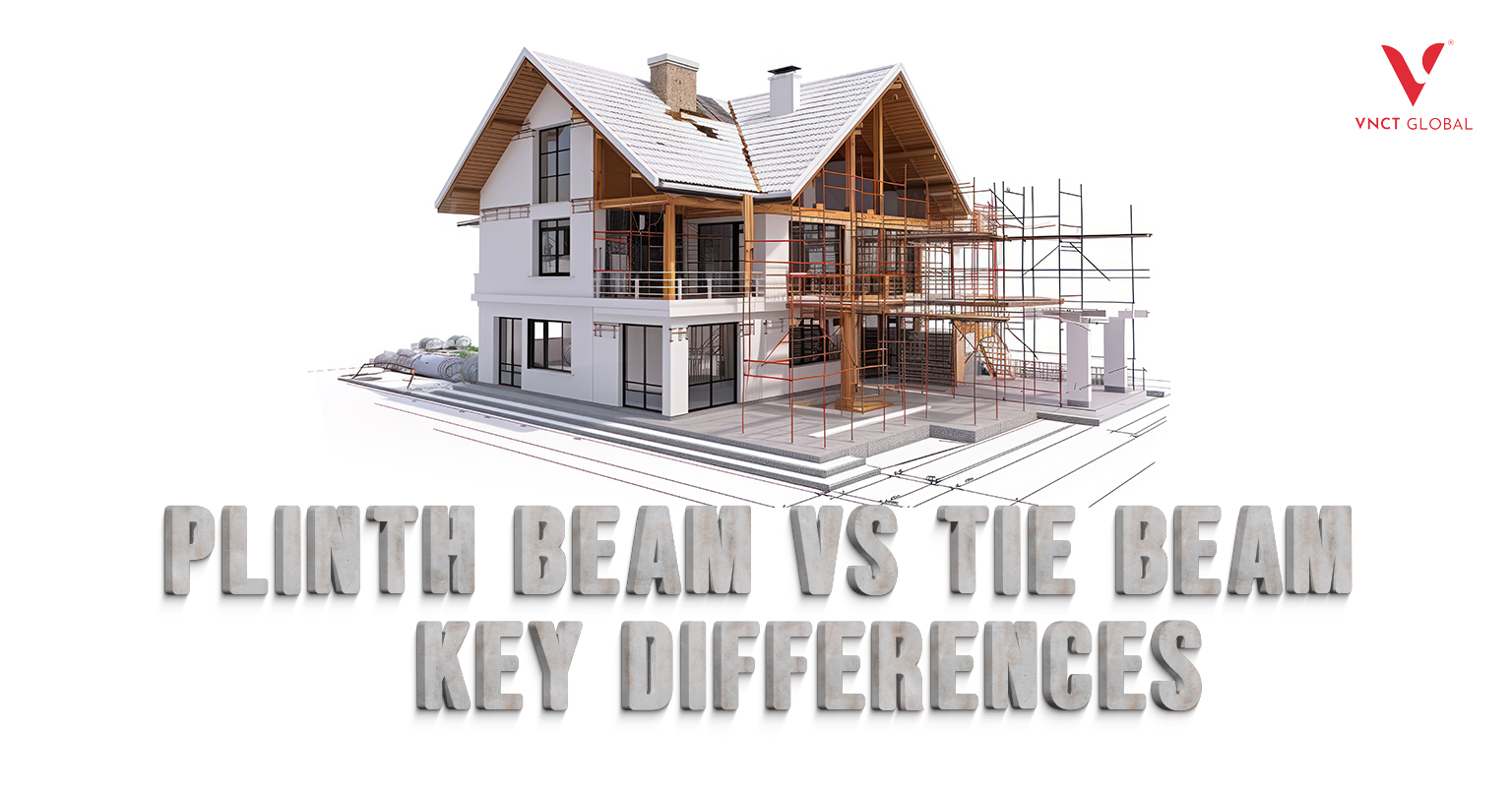Introduction
Plinth Beam vs Tie Beam these two structural elements are often mentioned together, but they serve very different purposes. Understanding their distinction is crucial whether you’re designing your dream villa, supervising a construction project, or investing in property remotely.
If your villa project is located in Chennai, Madurai, or Coimbatore or part of VNCT Global’s premium developments like Brookside Residences, Palm Beach, Creek Residences, Park Villas, or Ocean Drive Villas, having clarity on these foundational elements can make a big difference in your home’s strength and lifespan.
As one of the best villa developers in India and also among the largest villa developers in India, VNCT Global focuses on precision engineering and quality construction. For our NRI clients, we go a step further offering transparent communication, expert supervision, and detailed updates throughout the building process. With VNCT Global, you can be confident that every beam, column, and foundation element is designed and executed with care, even when you’re miles away.
Overview of Plinth Beam
A plinth beam is a reinforced concrete beam placed at or near the plinth level of a building (i.e. just above ground level). It forms the transition between the foundation/substructure and the superstructure walls. Its key roles include transferring the loads from the walls to the foundation, preventing differential settlement, tying together columns at the base, and resisting moisture intrusion or cracks from ground movement.
Typical specifications for plinth beams depend on soil, loads, and design, but often they are sized to match wall thickness and reinforced with suitably sized TMT bars (e.g. 10 mm to 16 mm in many residential projects) with proper stirrups.
Because the plinth beam connects all base-level structural elements, it also helps maintain alignment between columns and supports the walls above.
Overview of Tie Beam
A tie beam is a horizontal structural member provided between columns (or between parts of structure) at points above the plinth (i.e. higher than plinth level). Its main purpose is not to carry the vertical loads of walls or slabs, but to “tie” columns together and reduce their unsupported length, thereby reducing the risk of column buckling, lateral displacement, or misalignment.
Tie beams are also used in roof truss frames or intermediate floors, especially when column heights become large. They help stabilize structural geometry, resist lateral forces, and maintain rigidity.
Unlike plinth beams, tie beams generally don’t directly bear the load of wall or slab weight (although some axial or minor loads may pass through), but serve more as structural bracing.
Plinth Beam vs Tie Beam
Function and Location
- Plinth Beam is located at the base, just above the foundation or basement level, forming a horizontal tie at ground level between columns and walls.
- Tie Beam is placed above plinth, connecting columns higher up (for instance between floors or at roof level) to prevent column buckling and maintain structural integrity.
While sometimes tie beams are given right at the plinth level, in such cases they become called plinth beams. So one way to see their relation is: tie beam is a general term; plinth beam is the tie beam variant at the plinth level.
Design Considerations
- Loads: Plinth beams handle vertical loads from walls and transfer them to foundation. Tie beams largely handle axial or lateral loads (less vertical loads).
- Span & height: Tie beams are used when column height exceeds a safe slenderness, requiring bracing. Plinth beams typically have shorter spans and less height.
- Reinforcement: Tie beams may need more reinforcement for bending or lateral stresses; plinth beams focus more on compression, shear, and distributing loads from walls.
- Cracks & settlement: Plinth beams help prevent differential settlement cracks or wall settlement by tying the base. Tie beams help reduce cracking or instability higher up in the columns.
Load Distribution
- Plinth Beam: Distributes loads from the walls to the underlying foundation or footings, helps uniform load transfer.
- Tie Beam: Doesn’t generally take heavy vertical wall loads; it distributes lateral stresses, resists bending or lateral displacement, and helps share loads between columns when lateral loads occur (wind, seismic).
Construction Materials
Both beams are normally constructed in reinforced cement concrete (RCC) using high-grade cement, coarse and fine aggregates, and TMT bars with stirrups, as per structural design. The difference lies in the design mix, reinforcement detailing, cover, and design standards.
For example, in many villa constructions, plinth beams will use reinforcement sized to carry wall loads (e.g. 10 mm–16 mm bars) while tie beams might require somewhat higher reinforcement (12 mm–20 mm) depending on span and lateral forces.
Applications of proper DPC (damp proof course) and waterproofing is more critical at the plinth level to prevent moisture ingress.
Applications
- Plinth Beam: Essential in almost all framed buildings villas, multi-story homes especially on uneven soils, slope sites, or where differential settlement risk exists.
- Tie Beam: Used where columns are tall, in multi-storey or high ceiling villas, in seismic zone projects, or when roof trusses or intermediate bracing is needed.
In premium villa developments built by the best villa developers in India and largest villa developers in India, including in villas in Chennai, villas in Madurai, villas in Coimbatore, and communities like Brookside Residences, Palm Beach, Creek Residences, Park Villas, Ocean Drive Villas, we ensure correct placement of plinth and tie beams. At VNCT Global, we help NRI clients understand these structural details, review designs, and supervise construction to ensure no shortcuts in beam design or placement.
Structural Benefits
- By combining both plinth beam and tie beam properly, structures become more robust, stable, and crack-resistant.
- Plinth beams reduce differential settlement, protect against ground moisture, and provide a level base for walls.
- Tie beams strengthen column stability, reduce slenderness effect, distribute lateral loads, and prevent buckling failure under axial loading.
- Together, they improve the overall frame action of the building, making it more resilient under wind, seismic or load variations.
For NRI investors, ensuring these structural systems are correctly designed and executed is a significant differentiator in build quality. VNCT Global supports by validating structural drawings, coordinating with consultants, and doing quality audits—even when you’re abroad. So if you wish to contact us VNCT Global, we are ready to walk you through these structural beams in your villa design.
Conclusion
In summary, Plinth Beam vs Tie Beam the distinction lies in location, function, and load handling. Plinth beams operate at the base, transferring wall loads and anchoring the structure to foundation, while tie beams operate higher up, connecting columns to resist lateral forces and prevent buckling. Both are essential for structural integrity, especially in villas and premium homes. In any project whether in villas in Chennai, Madurai, Coimbatore, or elite communities like Brookside Residences, Palm Beach, Creek Residences, Park Villas, Ocean Drive Villas using these beams correctly is non-negotiable for durability, safety, and value. As one of the best villa developers in India and among the largest villa developers in India, VNCT Global ensures these fundamentals are never compromised for aesthetics. For NRIs, we act as your on-ground partner, coordinating, inspecting, and assuring every beam is placed right.
FAQs for Plinth Beam vs Tie Beam
- Can a tie beam be used in place of a plinth beam?
No. While tie beams and plinth beams are related, a tie beam above plinth cannot substitute for the vertical load and settlement control functions of a properly designed plinth beam. - Do all villas need tie beams?
Not always. Tie beams are essential when column heights are large, in earthquake zones, or when additional lateral bracing is required. In single-story low buildings, tie beams may be minimal or limited. - Does a plinth beam prevent moisture seepage?
Yes. Plinth beams act as a physical barrier above ground level and help prevent rising dampness or water ingress into walls at the base. - How do I check whether beam design is correct as an NRI client?
Ask for structural drawings, beam reinforcement schedules, load calculations, deflection checks, and a third-party audit. VNCT Global can guide you to verify or commission these. - Which is more critical for structural integrity plinth beam or tie beam?
Both are critical in their domain: plinth beams for base stability and load transfer, tie beams for column stability and lateral force resistance. Skipping or misdesigning either compromises the structure.





